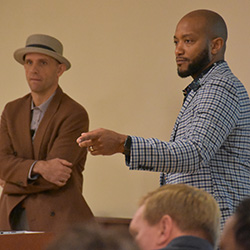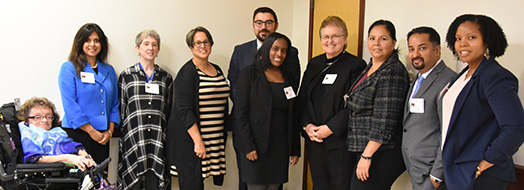 Facilitators Chris Armstrong and Vince Brantley, of Veritas Culture in Washington, DC during their workshop “Diversity and Inclusion: Forging a Path.”
Facilitators Chris Armstrong and Vince Brantley, of Veritas Culture in Washington, DC during their workshop “Diversity and Inclusion: Forging a Path.”
On October 23, members of the Connecticut Bar Association (CBA) Diversity & Inclusion Summit Committee gathered with other leaders in the legal profession for the fourth annual Connecticut Diversity & Inclusion Summit: The Collaborative Blueprint at Quinnipiac University. Each attendee received a copy of Dare to Lead: Brave Word. Tough Conversations. Whole Hearts. by Brené Brown to further the conversation beyond the day’s discussions.
Through collaborative workshops and panel discussions, attendees gained knowledge and inspiration to help lead their organizations into a revolutionary transformation that will make a positive effect in the realm of diversity and inclusion in the State of Connecticut.
Christine Jean-Louis, chair of the Diversity & Inclusion Summit Committee, explained the event’s emphasis on workshop style discussions for this year: “Every year the Summit builds on work from the following year. With this being the fourth year, we all have learned that diversity does not work without inclusion. Therefore, building on all the tools we gained the prior three years, we have reached a point where an intimate breakout session was necessary. This session allowed us to dive into the nuances impeding diversity and inclusion initiatives, such as human behavior, personal discomfort and self-preservation instincts that frustrate true inclusivity within an organization.”
This year's summit discussed the systemic and internal dynamics that negatively impact the ability to recruit, retain, and promote diverse talent as well as how to obtain the necessary tools toward retaining diverse talent and advancing them within an organization. The morning began with facilitators Chris Armstrong and Vince Brantley, of Veritas Culture in Washington, DC, who created an environment for attendees to discuss challenging topics openly and honestly. The facilitators emphasized the importance of leaders recognizing their diversity and inclusion challenges, and understanding their own role in effectuating change. Attendees of the workshop participated in a candid dialogue with both the facilitators and colleagues, sharing personal experiences, asking questions, and suggesting possible courses of action. The facilitator’s key message mirrored the summit’s format: the most important piece in making progress is recognizing that people drive the culture, systems/processes, and dynamics of an organization, and it is important to create an environment in which people listen to understand, and then take action.
The afternoon programing continued with panelists David R. Jimenez, Felice Gray-Kemp, and Meghana D. Shah along with moderator An-Ping Hsieh, who discussed their own narratives of diversity throughout their legal careers and participated in an interactive discussion with attendees.
The keynote address was presented by E. Macey Russell on “The Employer’s Role with Diverse Hires,” and provided insight into why law firms fail to mentor diverse attorneys, protect or shield them from microaggressions, or make them feel comfortable.
The Summit serves as an annual benchmarking point for the signatories to the Connecticut Legal Community’s Pledge & Plan. Signatories respond to an annual survey, sharing their demographic data and progress on the goals of the prior year of the Pledge & Plan. CBA Vice President Cecil J. Thomas, who led the development and launch of the Signatory Initiative in 2016, presented an overview of the data shared by the signatories, and previewed plans for the Signatories Year Four Focus on Retention. “Successful diversity, equity, and inclusion efforts are intentional, strategic, and accountable,” said Attorney Thomas. “Assessment data, such as that presented at the Summit, allow us to look at our representation successes and challenges, and benchmark our progress for future improvement.” This year’s collected data, he noted, showed small but measurable gains in the representation of diverse individuals in the legal community since 2018. Notwithstanding the measurable gains, there is still work to be done on the retention and advancement of diverse talent and the collection of data for those with disabilities, members of the LGBTQ+ community, or those who self-identify differently from the ethnicities provided.
The Diversity & Inclusion Pledge & Plan reflects a reaffirmation of the legal profession’s commitment to approaching diversity and inclusion strategically, collaboratively, and with accountability. The Pledge & Plan, along with the 37 organizations that have signed on, may be viewed at ctbar.org/pledgeandplan.
CBA President Ndidi N. Moses provided closing remarks, which stressed the importance of the presence of the attendees at the summit. “You have joined a community of legal practitioners who understand that diversity and inclusion efforts work to advance the interests of us all, irrespective of our race, ethnicity, color, national origin, religion, gender, sexual orientation, disability status, or socio-economic status….Armed with the knowledge of our aligned interests, we look forward to your continued participation in our efforts to develop innovative ideas and solutions to enhance diversity and inclusion in the legal profession in Connecticut,” she stated.

Members of the Diversity & Inclusion Committee at the summit.